オハラはパンデミックが始まる直前に、アーティスト・イン・レジデンスのためイタリアのヴェネチアに移り、ここ2年ほどアメリカに帰国することはなかった。インタヴューを行ったのは、ちょうどオハラがニューヨークに戻り、これまで使っていたアトリエを引き払ったり、イタリアに戻るためのビザの手続きをしている真っ只中。コロナ禍をどのように過ごし、どのような作品を手がけてきたのかを聞かせてもらった。
COVID-19と19のドローイング
COVID-19 and 19 Drawings
はじめに、パンデミックの最中にあなたが手がけた19のドローイングについて聞かせていただきたいと思います。ニューヨーク・タイムズの記事やヘッドラインを切り抜きはじめたんですよね。2020年3月というパンデミックの最初期において、どんな印象や心配、考えをもっていましたか?
I’d like to start asking about the nineteen ink drawings you were working on during the pandemic. You started clipping articles and headlines from the daily New York Times. What were your impressions or worries or views at the very beginning of the pandemic, in March 2020?
2020年の3月、ロックダウンで足止めになったとき、わたしはドイツのチュービンゲン大学で教える仕事をしていました。COVID-19のために、イタリアに戻ることができなくなってしまいました。症状が出て、亡くなる人もいるとても厳しい時期でした。わたしも他の人たちと同じように、何が起こっているのか、COVIDとは何なのか、どのようにそれに対処すべきなのかを理解しようと必死でした。ロックダウンで足止めされたとき、私は大学のゲストハウスに滞在していました。28部屋あったのですが、3人のスタッフの他にその建物にいるのは私だけでした。誰もCOVIDやロックダウンがどのくらい続くか分かりませんでした。それは世界中で国によって異なっていました。私にとって、ドイツでは結局3ヶ月間、ヴェネチアに戻った際には夏の数ヶ月間の外出規制がありました。
In March 2020 I was teaching at the University of Tübingen in Germany when I got stuck in lockdown. COVID came and I couldn’t get back to Italy. It was a very challenging time because many people were getting sick and dying. Along with everyone else I was trying to figure out what was happening, what was COVID, how should we deal with it? When I got stuck in quarantine, I was living at the University guest house. They had 28 guest rooms, but I was the only person in the building, apart from three staff people. Nobody knew how long COVID or the quarantine would last. It was different from country to country around the world. For me the quarantine lasted three months in Germany and again during the summer for several months when I was back in Venice.
ある日部屋から降りていくと、朝食のテーブルにニューヨークタイムズが置かれていたんです。駅でわざわざ私のために[新聞を]買ってきてくれた[ゲストハウスの]スタッフによるとても優しい配慮に驚きました。その週にはスタッフが会議室を制作スタジオとして使えるようにしてくれたので、切り抜いた記事をテーマ別にグループ分けして壁に貼ることを始めました。教育の分野、医療の分野、スポーツの分野、政治の分野、交通の分野など[分野ごとに何が起こっているのかを]理解しようと試みました。あらゆることがよく分からないなか、ただCOVIDは危険だということは理解しました。
One day when I came downstairs, the New York Times was on the table by my breakfast. This surprise was a thoughtful and generous action on the part of a staff member who bought it for me at the train station. That week the staff gave me a conference room to use as a studio, so I started cutting out the articles in the newspaper, putting them on the wall in groups by theme. I was trying to figure out what was happening in the education, in health, in sports, in politics, in transportation. Everything seemed unknown, and I understood that basically COVID was dangerous.
インクでドローイングを行うことを考えていましたが、何にフォーカスするのかはまだわかっていませんでした。でも私には[制作のための]スペースがありました。それから徐々に、COVID-19と呼ばれるものだから19のドローイングをすることに決めたのです。
I thought about doing drawings in ink, but I didn’t know what I was focusing on but I had the space. Gradually I decided the virus is named COVID-19, so I will do 19 drawings.
友人がアート用品店に連れて行ってくれました。わたしはセンネリエインク(Sennelier shellac inks)を選びました。それまで使ったことがないものだったという理由で選びました。COVIDについて何も知らないから、自分が知らない材料を使ってみるべきだと思ったんです。
A friend drove me to an art supply store and I was able to get some art materials. I chose Sennelier shellac inks, because I had never worked with them. I didn’t know much about COVID, so I thought I should use materials that I didn’t know.
新聞紙面に[COVID-19に関連する]図表が出始めると、ウイルスをとらえたたくさんの棘がある球体の電子顕微鏡写真が掲載されるようになりました。そこで円/丸に取り組んでみようと決めました。円/丸は容器です。私たちはCOVIDを抑え込もう(contain)としていました。 はじめのうち、COVIDのどの側面がどのドローイングに表されているのか、直接的に考えていた訳ではありませんでした。一連のドローイングを仕上げてから、それぞれの特徴について考えはじめました。2020年の3月にはじめ、その年の11月末までに3つのシリーズを制作しました。1シリーズにはそれぞれ19のドローイングがあるので、合わせると57の作品ができたことになります。
When the diagrams started to appear in the newspaper, microscopic photographs they pictured it as round with many spikes, so I decided to work with the circle. A circle is a container. We were trying to contain COVID. In the beginning I wasn’t thinking directly about which aspect of COVID was represented by which drawing. It was only after I did the series of drawings that I started to think more specifically of each drawing. I began in March 2020. By the end of November 2020 I had 3 series, each with 19 drawings, making a total of 57 works.
それは進化のプロセスでした。わたしが[作品に]取り組むことで、COVIDについて学ぶことも、[センネリエ]インクについて学ぶこともよりも発展し進んでいきました。そしてついに、それらのドローイングのうちのいくつかが完成したと思えたのです。そこでドローイングに新聞記事を組み合わせることを思いつきました。だんだんと、あるドローイングはコミュニケーションについて、あるいは教育や医療の問題についてとすることが意味をなしてきました。それは直感的で即興的なプロセスでした。
It was an evolutionary process. Learning about COVID was evolving and learning about the inks was growing as I worked. Finally a few of them seemed finished, and then I got the idea of attaching the newspaper articles to the drawings. Gradually it made sense that one was about communication or education or medical problems. The process was intuitive and improvised.
どのようにドローイングと記事を組み合わせたのですか?
How did you match the drawing and articles?
直感です。全てが同じ部屋にあって、壁にそのまま全部並んだ記事と床に敷き詰めたドローイングを見て、自分の直感に従いました。ドローイングに記事を置いてみて、それが合うかどうか見ました。次にそれぞれのドローイングの裏に適切な記事を貼り付けることにしたのです。
It was intuitive. I had everything in the same room, and I saw all these articles on the wall and the drawings all over the floor and following my intuition, I placed articles on drawings to see if they fit. Next I decided to glue the appropriate articles to the back of each drawing.

Morgan O’Hara
COVID-19 #2 Isolation on Wheels, 2020
Courtesy of the Artist
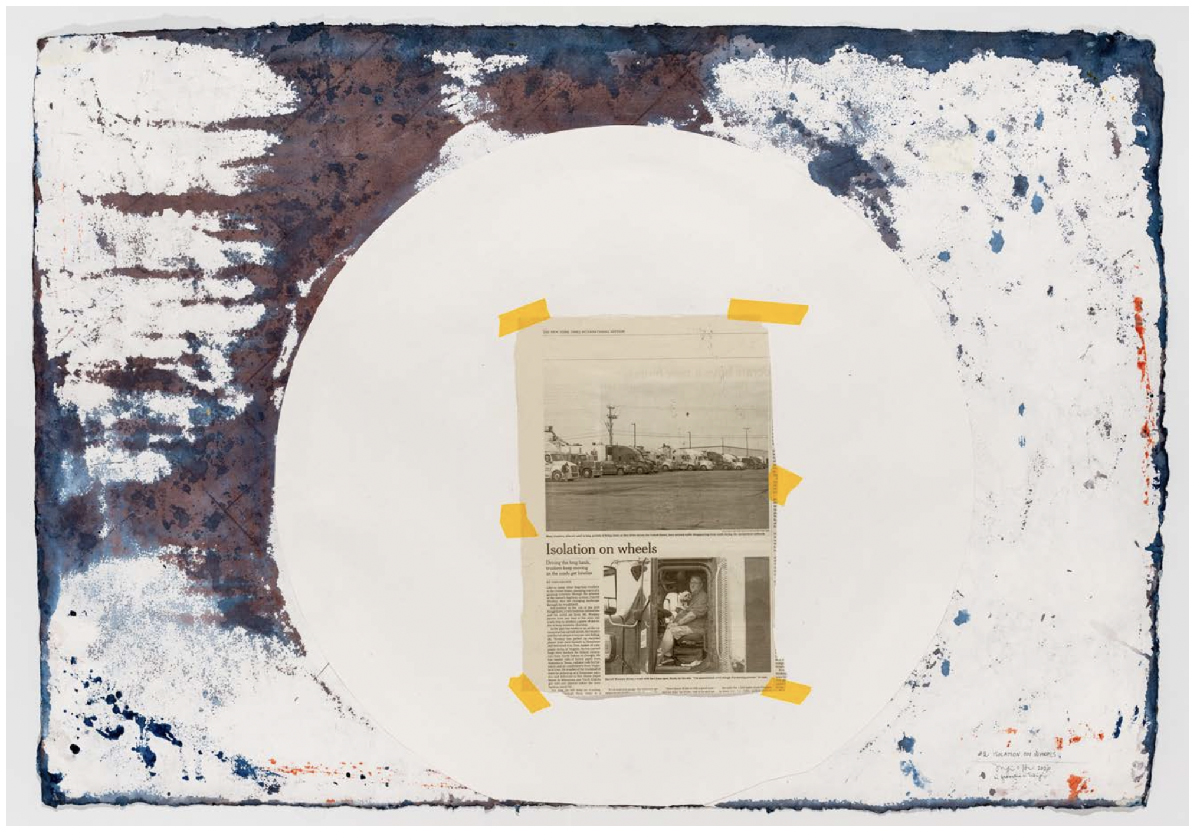
Morgan O’Hara
COVID-19 #2 Isolation on Wheels, 2020
Courtesy of the Artist
ヴェネチアに戻って
Returning to Venice
6月1日から8月31日までの2つ目のシリーズでは[一方のページに]ドローイングがあり、もう一方のページに新聞記事をおきました。イタリアに戻ってから制作した3つ目のシリーズでは、ドローイングの中に記事を貼り込みました。ヴェネチアでは各国の新聞が簡単に手に入るので、ニューヨークタイムズに加えて、イタリアのコリエーレ・デラ・セーラと、ドイツのフランクフルター・アルゲマイネ、スペインのエル・パイス、フランスのル・モンドも使うようになりました。
For the second series from 1 June to 31 August, on one side I had the drawing, and on another page to its right, I put the newspaper articles. For the third series, when I was back in Italy, I glued the newspapers right into the ink drawings. In Venice I had easy access to international newspapers and started using the newspapers from Italy – La Corriere della Sera, Germany – Frankfurter Allgemeine, Spain – El Pais, France – Le Monde in addition to the New York Times.
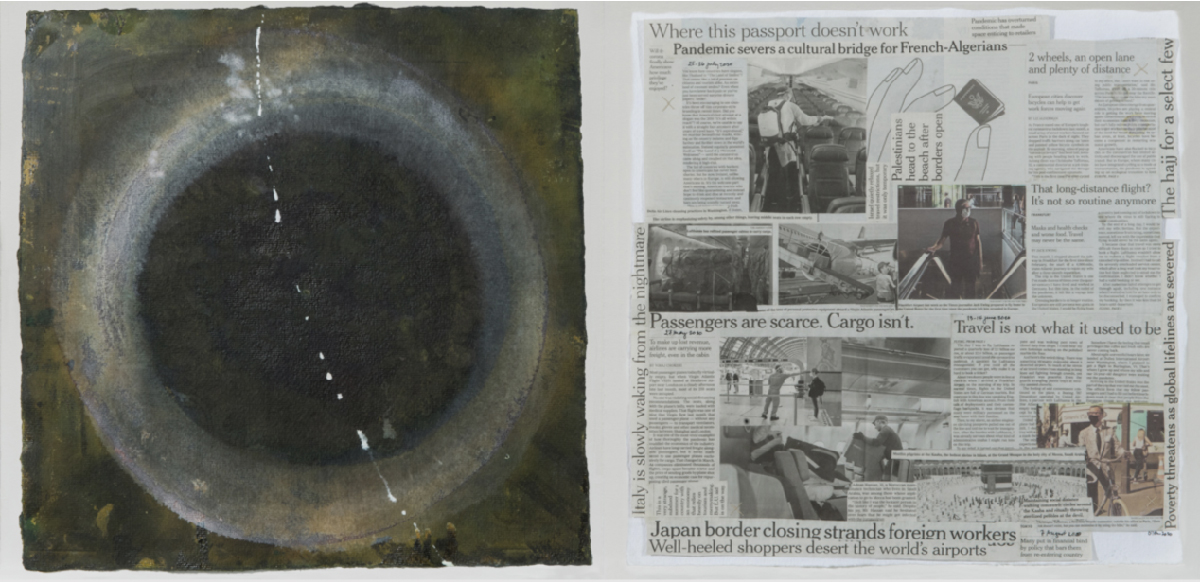
Morgan O’Hara
COVID_19_2: NINETEEN SHIFTS IN CONTAINMENT
NO. 6: TRAVEL IS NOT WHAT IT USED TO BE, 2020
Courtesy of the Artist
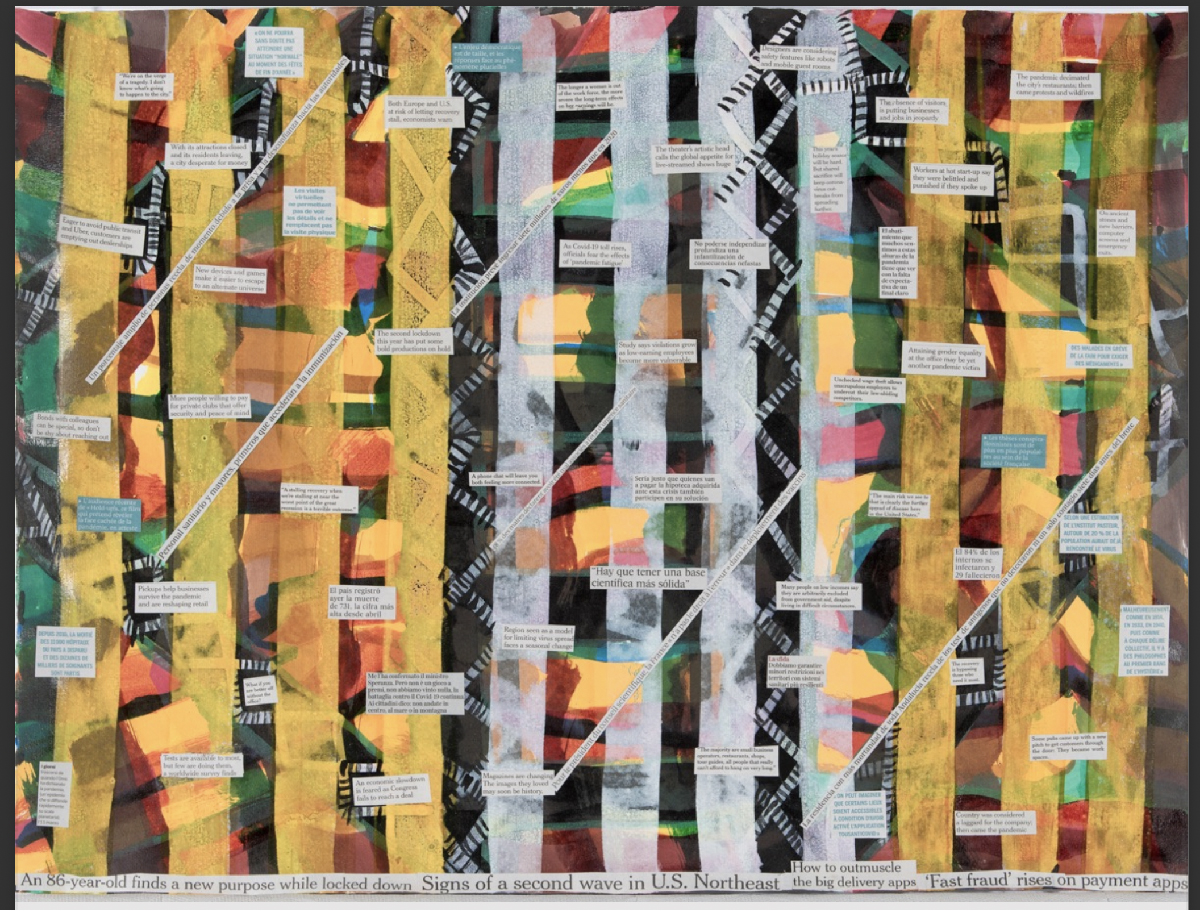
Morgan O’Hara
COVID_19_3: NINETEEN ATTEMPTS AT CONTAINMENT
#7 FATIGUE: Hay que tener una base cientifica más sólida / You have to have a more scientific base, 2020
Courtesy of the Artist
4つ目のシリーズを制作する予定はありますか?
Are you going to work on the fourth series?
ないですね、もうそのテーマにうんざりしてしまいました(笑)
No. I’m sick of the subject. (laughter)
(笑)もう学び終えたということですか?
It means that you’ve learned all?
全く違います(笑)!みんな違った考え方を持っていて、その国も異なったやり方で問題に取り組もうとしているということが分かりました。それに、そんな問題は存在しないというふりをしている人たちや、情報を歪めたり、情報を隠したり、故意に誤った情報をつくりだす人たちがいるということを学びましたね。そこらじゅうで、そのウイルスや変異種に感染したり、亡くなる人がまだいます。
Absolutely not! I’ve learned that everyone has different ideas, and every country has different systems of how to take care of problems. Then there are people who pretend the problems don’t exist and those who distort information, hide information, deliberately create misinformation, etc. Everywhere people are still getting infected and dying from this virus and its mutations.
とても政治的な事柄になってしまったと思います。
It turns out to be a very political thing, I think.
そう、むちゃくちゃです。わたしは9ヶ月間これに取り組んで、それぞれのシリーズに3ヶ月を費やしました。9ヶ月後には、もううんざりしてしまっておしまいにしました。それを終えた途端、COVIDに感染してしまったんです。作品を作り終えたら、COVIDに感染したんです。ひどいでしょう。
Yes, it’s crazy. So the crazy thing for me was I worked on this art for 9 months, 3 months for each series. After 9 months I was so sick of it I stopped. And then I got COVID. After I stopped doing the art, I got COVID. Crazy.
それらのドローイングがあなたを守っていたみたいですね。
Sounds like those drawings protected you from COVID.
おそらく。そう言ってしまうのもばかばかしいですが…
Maybe. It’s ridiculous to say that, but…
大丈夫でしたか?そんなにひどくはありませんでしたか?
Were you OK? Was it not so hard?
1ヶ月くらいかなり辛かったです。[規制のため]2週間は食料を買いに出かけることができませんでした。でも何も食べたくなかったし、お腹もすきませんでした。ヴェネチアには料理が上手な日本人の友人がいます。彼女が野菜料理をタッパーに入れていくつも持ってきてくれました。「食べないとだめだよ」って。彼女のおかげで、私は食べ始めて元気を取り戻しました。
It was pretty hard for about a month. For two weeks I couldn’t go outside to buy food. At the same time I didn’t want to eat. I wasn’t hungry. I have a Japanese friend in Venice who is a good cook. She brought me many containers of home cooked vegetables, saying “you have to eat” and thanks to her I started eating and getting my strength back.
優しいですね。ヴェネチアにはどのくらいになるのですか?
That’s very kind of her. How long have you been in Venice so far?
2年ですね。COVIDが始まる前、2019年の12月にエミリーハーヴェイ財団のアーティストインレジデンスに滞在していました。
2 years. Before Covid, in December 2019 I was doing an artist residency at the Emily Harvey Foundation.
それが終わった後も留まろうと思ったんですね。
You decided to stay there after the artist residency.
そう、とても気に入ったから。そしてコロナ禍が始まりました。なのでニューヨークには2年間戻ってきませんでした。新聞を読むたびに、ニューヨークに戻るのは危険に思えたからです。フライト自体、マスクの着用やソーシャルディスタンスを守ることをを拒否して、乗客がアテンダントと喧嘩するなど[危険に思えました]。ひどいものでした。それに危険でした。機内中の人々がウイルスに晒されるのです。だから飛行機からもニューヨークからも遠ざかっていました。イタリアは最初にウイルスの被害を受けた国の一つで、多くの人が亡くなっています。だからイタリアの人たちはCOVIDをとても深刻にとらえ、うまく状況をコントロールしていました。
Yes, I liked it there. And then COVID hit. I didn’t come back to New York for two years. Each time I read the newspaper, it seemed very dangerous to return to New York. The flight itself: people were fighting with flight attendants and refusing to wear masks or to keep social distance. It was terrible. And dangerous. Whole planeloads of people were contacting the virus. So I stayed away from planes and from New York. Italy was one of the first countries hit by the virus and many people died so the Italians took it seriously and kept things under good control.
職人の/とドローイング
Drawing of/with Artisans
COVID-19はあなたの制作活動にどのような影響を与えましたか?
How did COVID-19 influence your art making practices?
重要なのは、たくさん自由な時間ができたという点だと思います。わたしはそれを全てアートの制作のために費やしました。ギャラリーも開いていないし、[展覧会などの]オープニングもないし、ミュージアムも全て閉まっていたから、ただひたすら作品をつくりました。そのうち、職人もアーティストも、みんなおそらく家やスタジオで仕事をしているだろうということに思い当たったんです。近所に面白そうなことをしている職人を見つけて、その人が仕事をしている様子を描かせてもらうことになりました。
I think important was that I had so much free time. I used it all to make art. There were no galleries open, no openings, and museums were closed so I just made my work. Gradually it occurred to me that artists and artisans were probably in their studios working, too, so I found one interesting artisan near my apartment and asked if I could draw while he worked.
その人はゴンドラのオールとオール受けを作っていました。お互いが大きな工房の反対側で離れて作業できたので、マスクなしでも距離は保たれていました。わたしは、彼の工房でドローイングをはじめました。その後、彼は別の職人を紹介してくれて、そうしてほとんど1年間、工房をめぐってドローイングを行いました。彼らは、ボートをつくったり、木を彫ったり、靴をつくったり、鋳物工場で真鍮をプレスしたり、金を打ったりしていました。彼らの[作業する]場所に入って行って、彼らの動きに合わせてドローイングを行いました。すごく面白かった。仕事場の写真も撮らせてもらいました。それはわたしにとって特別なことで、本当にすばらしかったです。
He was making forcole and oars for the gondolas. We were on opposite sides of the large studio so we didn’t have to deal with masks and the distancing was built in. So I started making drawings in his studio. Then he introduced me to another artisan and I spent a lot of time for almost a year making drawings going from one studio to another. They were making boats, carving wood, making shoes, forging brass objects in a foundry, hammering gold. I went into their spaces and made drawings of their movements as they worked. It was fascinating. I also made photographs of their spaces. It was very special for me. It was very good.
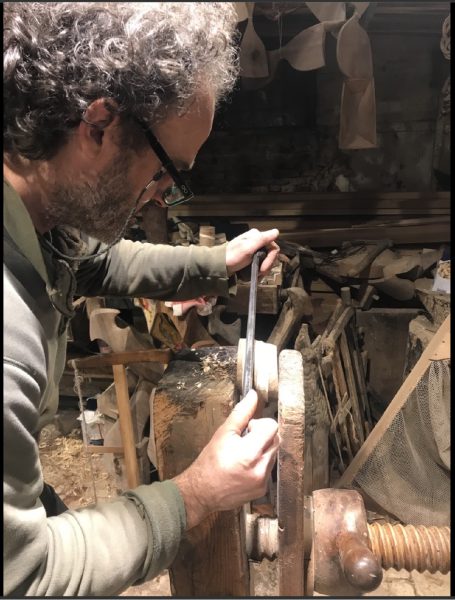
ゴンドラなどのオールとフォルコラをつくる職人
Oar and forcola maker, Paolo Brandolisio, 2021
Photo by Morgan O’Hara
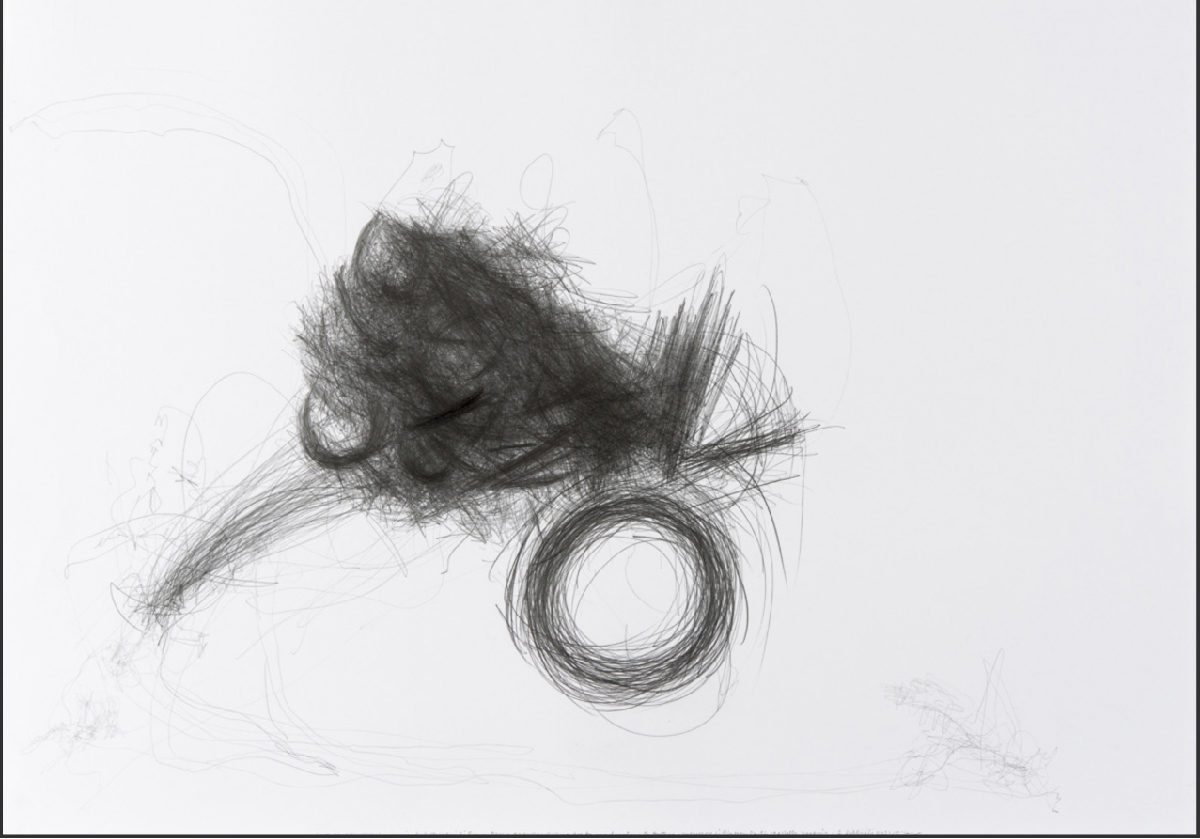
Morgan O’Hara
Live Transmission Drawings, Artigiani Venezia, 2021
Courtesy of the artist
新しい「LIVE TRANSMISSION」のシリーズですね。マカオの映像を見ました。
It’s a new LIVE TRANSMISSION series! I’ve watched the videos you made in Macau.
ドラマーのですか?Drummers?
Live Transmission Macau – Morgan O’Hara and Team Win
マカオ、塔石広場、2020年11月12日
それと麺をつくっている女性たちのです。
And women making noodles.
Live Transmission Macau – Morgan O’Hara and Va Heng Noodle Family
マカオ、Va Heng Noodle Family、2020年11月15日
そう、そういったことがCOVIDの最中のイタリアではできなくなったのです。パスタのお店には行くことができないからです。そういったお店は狭すぎるから。
Yes, but I couldn’t do those things in Italy during COVID, because I couldn’t go into the pasta shops because the spaces were too small.
ヴェネチアでやってみたら面白そうですよね。街中でいろいろなことが起こってそうです。いつもどうやって興味深いことをしている人を見つけるのですか?
It must be interesting doing this work in Venice. There must be many things going on in the street. How do you usually find people doing interesting things?
歩き回ります。ただ歩き回って、何が起こっているのかを観察するんです。でもCOVIDのあいだは、いつもアポイントをとって許可をもらうようにしています。
Walking around. I simply walk around and see what’s happening. During COVID, however, I always made an appointment and got permission.
以前ほど簡単ではなくなったと言うことですね。
So it’s not as easy as it used to be.
そうですね、マカオの映像であなたが見たようにオープンで自由に描くことは今はできません。それは[パンデミック下で]とても制限されてしまいました。というのも、マーケットやカフェやバーなどの屋内空間に行けなくなってしまったからです。COVIDのあいだは、安全なソーシャルディスタンスを保ちながら、わたしも相手も作業ができるという特別な状況を探さなければならなくなりました。「Live Transmission」を行うことはCOVIDのせいでとても制限されてしまいました。それがいちばん難しかった部分ですね。でも一般的にいうと、紙も鉛筆も見つけられます。そういったところには問題ありませんでした。でも社会的な側面が難しかったですね。マスクに気をつけることも鬱陶しかった。通常、他人を怪しんだりしませんが、COVIDにおいては、気をつけて、他の人から距離を取るようにしないといけません。ソーシャルディスタンスを保つのは困難でした。
To draw openly and freely as you seen in those Macau videos, I couldn’t do that now. I was extremely limited because I couldn’t go into the market, I couldn’t go to a cafe or bar or any internal space. During COVID I had to find special situations in which I and another person were working with a safe social distance between us. Doing LIVE TRANSMISSIONs were limited because of Covid. That was the hardest part, but in general, I was able to find paper and I was able to find pencils. The social aspect was challenging. Also being careful with masks was annoying. Normally I don’t feel suspicious around other people, but in the case of the COVID, I had to be careful and stay away from other people, so the social distancing was hard.
でも、作品の制作に本当に集中できた。
But you could really concentrate on art making somehow.
はい。他のアーティストたちが同じように言っているのを聞いたことがあります。隔離はあらゆることを切り離してしまうから。マスクをつけるのは嫌いだし、うんざりしています。でも、必要なことです。わたしは作品をつくりたいですが、オープニングに出かけて知り合いと2分間ずつ話すような表面的なことは好きではないです。だからCOVIDの時の静けさが好きです。ただわたしはヴェネチアにいたので、外出したければ運河沿いにグランド・カナルやビーチまででも歩けます。それはわたしにとってとても特別なことでした。そんな経験ができてありがたいと思っています。
Yes. I have heard other artists say the same thing. Quarantine cuts out everything else. I don’t like to wear masks, I’m tired of it, but it’s a necessary thing. I like to do work. I don’t like to go to openings, talking for 2 minutes to one person and then another. It’s superficial, so I enjoyed the quiet of COVID time. But remember I was in Venice. When I needed to go outside, I could walk along the canals to the Grand Canal or even go to the beach. It was very special to me. I’m grateful to have had this experience.
パンデミック後
After the Pandemic
パンデミック後、あるいはヴェネチアに戻ってからやりたいことはなんですか?
What would you like to do the most after the pandemic or when you return to Venice.
何をやりたいか… 友人たちと一緒にワインでも飲みながらおしゃべりすることでしょうか(笑)笑った?
What would I like to do… just sit with friends and talk, with a glass of wine. Ha ha ha ha.. You laugh?
パンデミックの状況ではそういうことをするのがどれだけ難しいか知ってます。
It was difficult to do that during the pandemic!
多くの人たちのようなひどい時間だったわけではないです。感染してしまいましたが、病院にも診療にも行きませんでした。ただひたすら寝て、終わりました。楽しいものではありませんでしたが。ひどい咳が続き、痛みもひどく、身体も弱ってしまい、筋肉が燃えているかのように感じられましたが、それで済みました。だから幸運だったと思います。今の問題は、ニューヨークで誰かと話をすると、いまだに会話はCOVIDについてばかり。もううんざりです。
I didn’t have a terrible time with Covid with the way many people did. I had COVID, but I didn’t go to the hospital, I didn’t see a doctor. I just slept and slept and slept and finally it ended. I mean it wasn’t fun. I was coughing and coughing and very sore and very weak and my muscles felt like they were on fire, and all that. But I was lucky. I think the problem now is that so much conversation is still about COVID and I’m sick of it.
このインタヴューもですね。
This interview, as well?
それはいいんです。みんなCOVIDについて違った経験や関わり方をしているから。わたしにはアートがあり、それが全てを乗り越えさせてくれたことにとても感謝しています!
It’s OK. Everybody has had a different experience with COVID. I am really grateful for my art practice which gets me through just about everything!
(2022年3月3日オンラインにて、聞き手:登久希子)
ロサンジェルス出身。戦後の日本で育つ。カリフォルニア州立大学でアートの修士号を取得。1978年にスイスのローザンヌにあるカントナル・デ・ボザール美術館で初個展を開催。キャリアを通して、世界中の様々な場所で暮らし作品を制作してきた。オハラの作品は、大英博物館、アーカンソー・アートセンター、プラハ・ナショナルギャラリー(チェコ)、アーマンド・ハマー美術館(ロサンゼルス)、ナショナル・ギャラリー(ワシントンD.C.)、メトロポリタン美術館など、世界各地の芸術機関に収蔵されている。詳しくはwww.MorganOHara.art
Morgan O’Hara was born in Los Angeles and grew up in post-war Japan. She earned her Master’s Degree in Art at California State University, LA. Her first solo exhibition was held in the Musée Cantonal des Beaux Arts in Lausanne, Switzerland in 1978. Throughout her career, she lives and works in many different parts of the world. Her work is in the permanent collections of many institutions, including The British Museum, (London), Arkansas Art Center (AR), Prague National Gallery (Czech Republic), Hammer Museum (CA), the National Gallery of Art (Washington DC) and The Metropolitan Museum of Art (NY). Please look at her website: www.MorganOHara.art

